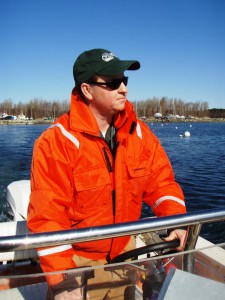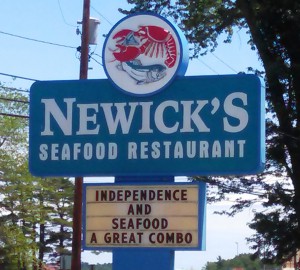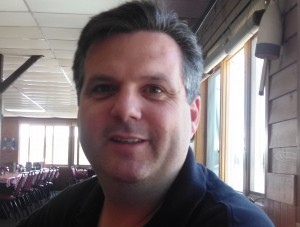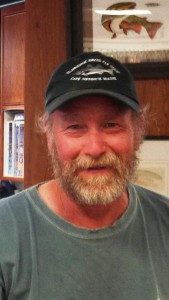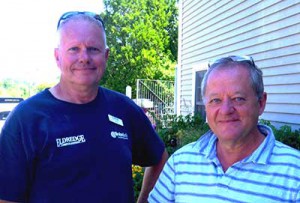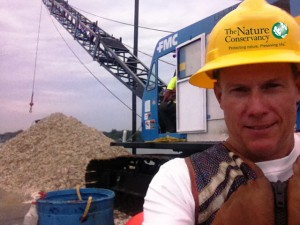Our Faces of Great Bay series profiles people who live near and love the Great Bay Estuary, and who are working to protect it today – and for future generations.
Representative Mindi Messmer
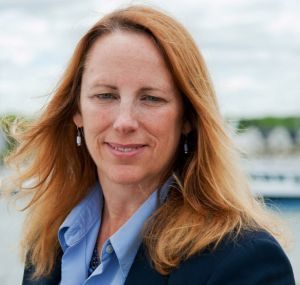
Former state representative Mindi Messmer of Rye has been an extraordinary advocate for clean water. Messmer served as a Rye, NH, resident appointee on the Governor’s Task Force on the NH Seacoast Cancer Investigation, which looked into possible causes for a cluster of Rhadbomyosarcoma (RMS) cancers in the Rye area – the first and only identified cancer cluster in New Hampshire. RMS is a type of sarcoma affecting soft tissue, connective tissue, or bone and is most often considered a childhood disease. The investigation included a search to identify environmental factors that may be contributing to the rise in RMS cancer rates.
The cluster’s proximity to the Coakley Superfund site in North Hampton raised a red flag for Messmer and others, leading to extensive efforts to assess the safety of this former landfill, which was closed and capped in the late 1990s. You can learn more about the Coakley landfill, including the lengthy list of hazardous wastes it accepted for disposal, here.
When CLF’s Great Bay–Piscataqua Waterkeeper engaged in water quality sampling in local brooks near the Coakley dump, and downstream, five miles away. Unfortunately, five of the six sites sampled indicated elevated values for perfluorinated chemicals, or “PFCs,” – persistent toxins that are pollutants of emerging concern. Messmer, working with a number of local citizens and stakeholders, steered the research and needed advocacy forward. Among other things, she introduced legislation to adopt more protective standards for PFCs. It did not hurt that she is a trained hydrogeologist. We can describe her in four words: intelligent, energetic, driven, and persistent.
Messmer had this to say: “PFCs and other chemicals in groundwater at Pease and the Coakley dump threaten drinking water supplies for Portsmouth, Greenland, Rye, and North Hampton. The crises we faced with the shutdown of the Haven Well in Portsmouth and the realization about the failure to appropriately address contamination migrating from the Coakley dump and their impacts on private and public drinking water should serve as a wake-up call. There is a dire need to be more vigilant to protect our drinking water and surface water resources to ensure the health and safety of our seacoast families.” Area residents are fortunate to have her leadership.
Molly McGovern
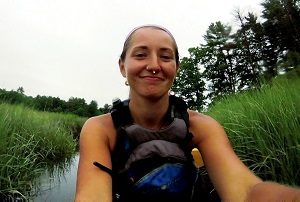
Molly McGovern loves the water. She is either on it, next to it, or under it. As a kayak guide and instructor with Seven Rivers Paddling of Newmarket, NH, Molly led and coordinated the company’s participation in CLF’s second annual Great Bay Kayak Cleanup last month. When not conducting private kayak tours on Little Bay, Great Bay, and the tributaries, Molly is working at the University of New Hampshire’s Jackson Estuarine Lab for Dr. David Burdick monitoring macroalgae – something we don’t want to see in the estuary in excess. She aspires to become an underwater research specialist.
Having graduated from UNH with a major in Environmental Conservation Studies, Molly is compiling an historic baseline of macroalgal growth in Great Bay and identifying the changing presence of macroalgee in the estuary over time. A conversation with her included a great deal of Latin. Suffice it to say, her observations are troubling and indicate a shift from the indigenous common rockweed and knotted wrack to other species – namely, sea lettuce, filamentous green macroalgae, and an invasive red one from the Orient that may have hitchhiked here on ships.
Molly’s frequent forays on the estuary, as a kayaking instructor and educator, have reinforced her photo-interpretative studies for Dr. Burdick. She observes that small patches of nitrogen-loving sea lettuce have grown into continuous beds covering several acres of shoreline mudflats. This proliferation is now common in many places around the bay.Very different from sea lettuce is the green filamentous macroalgae that can shift with the tides, winds, and currents – giving the shallow water a green hue. Altogether, these macroalgaes are thriving and choking out the essential eelgrass beds remaining in Great Bay.
Molly has seen changes in the Great Bay ecosystem. “I have noticed an increase in invasive macroalgal species both from a scientific perspective at our research sites, and from a recreational perspective while leading guided kayak tours,” she says. “The fact that these changes are visible over only three years tells me this is a bigger issue than most may want to believe.”
Around the world, estuaries just like Great Bay have been degraded with nutrient pollution from a variety of manmade sources like sewage plants and stormwater. It is my hope that people like Molly will continue to educate the public on what’s happening to our waters — and what we can, and must, do to protect them.
Laura Byergo
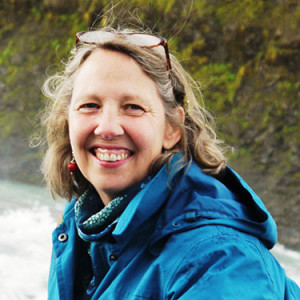
In 2011, Laura and her husband were driving around the New Hampshire seacoast looking for a place to retire. They visited the Discovery Center on the shore of Great Bay, fell in love with the area, and said this was the place!
Retired from the U.S. State Department – having worked in Indonesia, Mongolia, and North Africa – Laura was looking for a community where people really cared about the environment, and where she could satisfy her life-long interest in marine biology.
Her deck looks out onto the tidal section of the Winnicut River. It was perfect.
Laura loves the intimate habitat of the river more than the expansive ocean. I agreed with her when she said, “I can waste the better part of my day, watching the tide rise and fall in the river, and the comings and goings of everything living there – seen and unseen.”
Laura serves on the Great Bay Stewards board of directors and the Greenland Conservation Commission. She heads up the Winnicut River Watershed Coalition and was a driving force in advocating for a grant to fund a multi-town, watershed management plan.
She is definitely a hands-on person. Laura has helped plan and install rain gardens in the region and has conducted a survey of homes along the Winnicut to educate homeowners on strategies for minimizing stormwater impacts. She credits the Marine Docents, the Coastal Research Volunteers, and the Natural Resource Stewards with giving her the training to become an environmental volunteer.
Just what sort of changes does Laura want to see that will advance the goals of clean water and healthy ecosystems in and around the Great Bay estuary? “More value and emphasis on protecting animal habitat in built-up areas as our population grows is essential,” she says. “Our focus on clean water is often all about the needs of people, which is very important. But working for clean water is also about realizing that we share the planet’s limited resources with wildlife.”
Great Bay Marine, Inc.
Operated by the Griffin family since 1956, Great Bay Marine, on Little Bay in Newington, NH, is a year round, full service marina offering 128 slips and 72 moorings, indoor and outdoor storage, a public ramp, store, and restaurant.
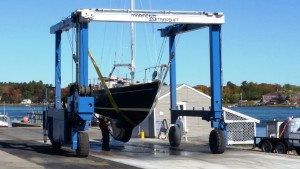
It is located midpoint between the open ocean and the head of Great Bay—about seven miles from each. The marina is the staging location for NH Department of Environmental Services and EPA vessels. In slip B12, you will find the Great Bay-Piscataqua Waterkeeper boat.
Some marinas have come under fire for failure to hold and/or comply with the mandatory Multi-Sector General Permit (MSGP), which regulates stormwater discharges resulting from industrial activities. Because they are located near water, marinas that fail to manage stormwater can cause pollution. Pressure washing, chipping, scraping, and sandblasting of anti-fouling bottom paint is a serious concern affecting clean water. Metals like copper, lead, and zinc as well as biocides may be present. The paint needs to be captured and disposed of properly.
Great Bay Marine does have an MSGP and is paying close attention to ways it can minimize pollution to the estuary. This fall, it installed a new wash station. The facility’s 35-ton carry-lift removes vessels from the water and transports them to the wash station, where power-washing occurs. A central drain collects all the water and any loose material from the hull. Filters capture the solids for approved disposal and the water is recycled to the power washer. When asked about the decision to install the expensive wash station, CEO Sean McKenna, remarked, “The wash pad has been in the company’s plans for the past few years and it was just the right thing to do. We want an environmentally friendly marina that will help sustain the estuary for generations.”
The marina’s current Stormwater Pollution Prevention Plan (SWPP) is linked right to its website. The detailed plan covers all activities on the 37 acre site—parking, storage, fueling, maintenance, and even the sewage pump-out services. It is obvious that Sean McKenna is paying close attention to potential stormwater issues. Future plans include more buffers and greenspace with native plants, and a reconfigured traffic pattern and parking lot. We’re fortunate to have a marina on Great Bay that understands the importance of water quality and is taking steps to protect it.
Chris Nash
As the Shellfish Manager for the NH Department of Environmental Services (NHDES), Chris Nash’s job is to keep the public safe from consuming tainted clams, mussels, and oysters. On the job for 16 years, Chris averages 2 to 3 days each week on the water – taking water samples, conducting surveys for pollution sources, and conducting studies – to determine which shellfishing flats can be harvested and when. The oyster farmers in Great Bay also depend on him to determine safe-harvesting windows.
Why is this so important? Under a variety of circumstances, shellfish can become contaminated with bacteria, viruses, chemicals, or even naturally occurring toxins, making safe human consumption a little dicey. A heavy rain can wash harmful bacteria from the land into the water. Red tide blooms can produce potent toxins that can temporarily accumulate in filter-feeding shellfish. If one of the many sewage plants around Great Bay fail to adequately disinfect, their NPDES permit requires them to immediately notify Chris. As well, mooring fields—all those boats that require dinghy access—are of concern. While it is unlawful to discharge any waste overboard, it does occur. Out of abundant caution, areas proximate to these vessel concentrations are either seasonally or permanently closed to shellfishing. Any recreational clammer in Great Bay or the Hampton-Seabrook estuary knows to check the clam hotline before venturing out.
Chris and the NHDES collaborated recently with the US Food and Drug Administration to conduct a dye study at Portsmouth’s Peirce Island sewage plant to determine the impact of that plant on shellfishing opportunities. The results were very instructive. Precautionary closures in areas previously open for harvest were put in place in 2015 while additional studies are conducted. Those closures will not change until Portsmouth upgrades to a higher level of treatment several years from now. Chris had this to say: “Based on current information, NHDES is optimistic that the new treatment process will greatly reduce possible sources of bacteria and viruses, allowing at least some of the recently closed areas to be reopened for shellfish harvest.”
Anyone who harvests or consumes shellfish from NH waters is fortunate to have Chris behind the scene. His dedication to the health and safety of both Seacoast residents and visitors alike is exemplary.
Newick’s at Dover Point
What’s big, red, and right on the shore of Great Bay?
If you answered Newick’s—the iconic restaurant at Dover Point, New Hampshire—you’re right. Opened in 1948, Newick’s has served seafood to generations of folks. I stopped in to see CEO Steve Newick late on a recent afternoon, when I thought the lunch crowd would be long gone. Wrong! At least 150 cars crowded the lot, two large retirement parties were going on, and the restaurant’s many, many tables were packed with hungry clients – while the staff of 40 rushed around serving them all. And still there was plenty of seating available.
When I asked Steve, the third generation of Newicks to run the iconic eatery, just how important Great Bay is to the restaurant, he said, “It is everything!”
The strip of land in front of Newick’s is a working waterfront. Steve’s brother is a commercial lobsterman in Great Bay and sells his catch to the restaurant. Oyster farming took off a few years ago and Newick’s promotes that fact by selling Great Bay oysters from Cedar Point Shellfish and Fox Point Oysters. In addition, Steve has printed information on the tables to let customers know that he participates in the Coastal Conservation Association of New Hampshire’s Oyster Shell Recycling Program that works to restore oyster reefs to Great Bay.
The restaurant’s carbon footprint is on Steve’s mind, too. Styrofoam containers and serving-ware have been pretty much replaced with biodegradable options. The facility is not air-conditioned and there are no plans to do so. And, the two-acre parking lot is mostly gravel—not impervious pavement.
Steve grew up on Great Bay. Besides Newick’s, the family retains property adjacent to the restaurant and across the bay on the Durham shore. I asked him how the area has changed over time. Steve responded that development had obviously increased, since everyone wants to live on the water. He anticipates the conversion of more property into condos as the trend continues and city sewer makes more development possible. “The change is inevitable,” Steve said.
People love to look at water. You go to a restaurant, and if there is a water view or a deck, that’s where you want to sit. Newick’s thrives, in part, because of Great Bay. My job, as the Great Bay-Piscataqua Waterkeeper, is to make sure that Great Bay waters are better tomorrow than today–local economies depend on it.
Mitch Kalter
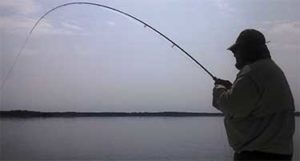
All fly fishermen are clean water advocates and Mitch Kalter is no exception. A committed member of Great Bay Trout Unlimited (GBTU) for many years, Mitch and others in GBTU have led the charge to educate youth, support dam removal, and replace culverts that hinder fish passage. They’ve also been great partners in supporting clean water initiatives in the Great Bay watershed.
With Mitch’s enthusiastic participation, GBTU was a key player in the dam removal on the Winnicut River, the removal of the Shorey Brook dam in Eliot, Maine, and the future removal of the Great Dam in Exeter, New Hampshire. All of these important projects benefit, or soon will, species like alewives, blueback herring, eels, and rainbow smelt that need access to fresh water. Improved dissolved oxygen levels also benefit from dam removal and are essential for healthy ecosystems.
If not for Mitch’s energy and stick-to-it-tive-ness, the Thompson Brook Project would disappear. Thompson Brook, a tributary of the Winnicut River that feeds Great Bay, is home to a remnant wild brook trout population – a rare find on New Hampshire’s Seacoast. “The natural world is sometimes resilient,” Mitch says. “We just need to undo some of the damage we have inflicted on it, and let it recover.” A very large and old culvert on a state highway is preventing the movement of this native brook trout population into the upper reaches of the watershed, yet the State of New Hampshire simply does not have the funds to undertake the project. Mitch has stepped up to take on the challenge, leveraging hundreds of thousands of dollars to replace the inadequate structure. If the funding goal is met, the project should be completed in 2016.
Mitch has also been an unwavering supporter of the Great Bay–Piscataqua Waterkeeper program, serving on the Waterkeeper Advisory Group and participating as a member of our Clean Water Advocates for Great Bay. He and others like him are the reason the program is thriving. Though cloning Mitch is out of the question, he is an exceptional volunteer – willing to do most anything to advance clean water initiatives – and is a great example to others.
Capt. Mark Drummond
Winter will not last forever, and in May the stripped bass will move north along the coast. Many fishermen I know are not about catching and eating fish (click here to view the NH Fish & Game Department’s advisory regarding fish consumption), but rather about catching and releasing. Capt. Mark Drummond of Kittery, Maine, has been guiding fly fisherman chasing after striped bass and bluefish in the Piscataqua River region for more than 17 years. He has a “no kill policy” — if you want to keep any of the fish you catch, you’ll have to find another guide.
For striped bass, most of the spawning occurs in the Chesapeake Bay and the Hudson River. In spring, the schools — mature and immature — migrate north along the coast following and searching for food — herring, squid, sand lances, crabs, baby lobsters — up to about mid-coast Maine. They return south in the fall, often in large schools, feeding as they go. These frenzied feeding events are called “blitzes” and fishermen anticipate them throughout the migration. “The last time I saw a real blitz was 7 or 8 years ago,” Mark says. “It has been a real disappointment.” He knows that there are many factors affecting bass numbers — food availability, water temperature, spawning rates, and conditions in the spawning areas — but something is definitely wrong.
When asked what other changes he’s seen over the years, Mark observes: “There are fewer stripers around because the mortality rate is way too high. Recreational fishermen kill a huge number of fish (click here to view the Atlantic States Marine Fisheries Commission’s Striped Bass Amendment). Keeping too many large, breeding females and poor release techniques of undersized or over-limit fish is the reason. And We also don’t see high numbers of fish being consistently born in the spawning grounds.”
The east coast’s striped bass stock is managed — along with other species — by the Atlantic States Marine Fisheries Commission (ASMFC). Mark believes that the managers stick to formulas and are unwilling to make needed adjustments quickly. “We are killing more fish than are being born,” he says. “The ASMFC holds to the concept of maximum sustainable yield. They always try to satisfy the commercial fishermen and the recreational guys. They need to put the fish first, and allow the stock to fully recover. Insuring that adequate forage fish are available at all stages of growth must be addressed at the same time. Ending the menhaden fishery in the Chesapeake Bay would be a good start.”
As if responding to Mark’s concerns, the ASMFC has recently recognized the plight of the striped bass and the declining numbers. An immediate reduction in the catch has been mandated coast-wide in order to protect the spawning biomass. New Hampshire has already instituted a 2015 bag limit of one fish over 28 inches. Maine is still debating what regulations to enforce.
Healthy fish stocks depend on healthy ecosystems that sustain the food web. When it comes to eelgrass — that essential ecosystem in Great Bay and the Piscataqua River — Mark has also seem changes. Where he takes his fishing clients is driven by where the best conditions exist, and eelgrass beds are likely to shelter food, making them perfect for predatory fish. But, says Mark, eelgrass in Little Bay and Great Bay has either disappeared altogether or is much reduced in volume and distribution. Too much nitrogen and turbidity is the culprit.
Out on the water, Mark shows me that the eelgrass beds at the mouth of the Piscataqua River are still in the same historic locations, but notes that they aren’t as thick and as lush as they used to be. Scientists suggest that eelgrass in the deeper water is disappearing because the diminished water clarity is not allowing photosynthesis to function optimally. Visiting several sites, Mark and I observe that the beds outside the river mouth look the healthiest — green and lush — while the beds in the river proper do not look as good. More tidal flushing may be the reason.
Mark loves the water and appreciates folks who also want to see healthy fish stocks and healthy ecosystems. The first depends on the second.
Working Hard to Protect Great Bay: New Hampshire Department of Environmental Services Oil Spill Response Team
New Hampshire’s Oil Spill Response team on the job replacing floating booms used to contain spills. When I went to the Great Bay Marina in Newington, New Hampshire, late in the summer, I found the boat ramp blocked by the color orange and several real sweaty guys from the New Hampshire Department of Environmental Services (NH DES). It was 95 degrees and very humid. None of the crew was in a humorous mood. The work was obviously dirty and slow. New Hampshire’s Oil Spill Response Team had started very early, but they were hard at it twelve hours later and were still not done.
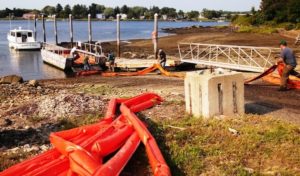
Carroll Brown, Jr., Coastal Oil Spill Response Coordinator, and Supervisor Rick Berry led the NH DES team in the task of replacing more than a mile of old, orange colored, floating booms that are staged on four moored barges in Little Bay. In the event of an oil or fuel spill from a source in the Piscataqua River, the NH DES and their subcontractors are prepared to deploy the booms to contain the spill as quickly as possible, thus reducing the contamination from traveling further into Great Bay or its tributaries. Once contained, the actual cleanup of any spill can begin.
The task that day was to remove the old cumbersome and heavy booms from the barges and wind it onto very large spools on trailers, called boom reels. Though it is quite old, it will not be discarded, but will be used in areas of reduced current, where less force is exerted on the boom. The task ahead is to unwind it, inspect, repair and clean it, and rewind it before transport to other needed staging areas in the state where none is currently available. The new boom – all 5,500 feet of it – will be deployed onto two of the four barges moored in Little Bay to stand at the ready. The $90,000 price tag is funded by a $0.125 per gallon assessment on imported oil.
Tides in the river and estuary are quite significant. A spill can travel fast and the time to deploy a series of containment booms can take a couple of hours depending on the location. Response times in the upper reaches of Great Bay might be longer and are complicated by the fact that there are important places with no road access, such as the lengthy railroad crossing over the mouth of the Squamscott River. In the event of a spill at a location like this, winter ice conditions will preclude any response at all.
While Carroll’s and Rick’s focus this day was staging the new and improved booms in Little Bay, their jobs encompass the whole state. The Spill Response and Complaint Investigation Section (SRCIS) not only includes response to petroleum and hazardous waste spills, but also covers investigating complaints related to improper handling and disposal of petroleum, and hazardous and solid wastes. SRCIS responds to a variety of spills and complaints including automotive accidents, residential heating oil spills, airplane crashes, illegal handling and disposal of infectious wastes, inspection of automobile salvage yards, asbestos disposal, and leaking underground and aboveground storage tanks.
When an oil spill occurs, the response is both complex and well-rehearsed. Local, state, and federal entities convene annually to rehearse and grapple with various spill scenarios so that if and/or when a spill occurs, all the players—those in the command center and those responders on the water—know exactly what to do. Anticipating and practicing what might go wrong is the best way to avert a catastrophe.
If you need to report a spill of any kind, start by calling 911 and your local fire department. You can reach the NH DES at 271-3899 during normal working hours, and after hours, via the State Police dispatch at (603) 223-4381. NH is fortunate to have the hard working Oil Spill Response Team on the job, looking out for our waters.
Scott Eldredge: Changing Buying Habits Where It Really Matters
Eldredge Lumber and Hardware does not technically lie within the Great Bay watershed, but many folks who do live along the Piscataqua in Southern Maine shop there. Everything – and I do mean everything – you could possibly need to build and maintain a home and yard can be found there – and that includes garden seeds, plants and flowers, fertilizers, insecticides, pesticides, you name it. Eldredge Lumber is not some mom-and-pop operation – it employs well over 150 people. But, its size and the variety of products for home construction and gardening is not what impresses me about the business and its owner, Scott Eldredge. It’s about what he won’t sell you. A change in personal opinions has altered what he will sell or recommend to the public as a businessman.
As Scott put it, he finally got fed up with eating food contaminated with insecticides and chemical fertilizers. His personal attitudes about clean water and healthy soils changed, and, with it, so did his business practices. He has grown very tired of the incessant ads in the media that have brainwashed the public that every bug is bad, or that every lawn fertilizer, herbicide, pesticide, and poison is an absolute must for every homeowner. Says Scott, “If a customer comes in, I want my staff to help identify the specific problem they have and then manage that problem in the least intensive way. There are alternatives. The spray-it-all or kill-them-all mentality just has to change for the sake of the only place we are ever going to live.”
Given that neonicitinoids may be detrimental to bees, he has erred on the side of caution and yanked them from the shelves. Unable to return them to the supplier, he is hoping to dispose of them at a hazardous waste collection day in town. “You can buy them, but you cannot give them back,” Scott says. “I feel strongly about not selling them, so I will take the financial loss.”
John Bochert works closely with Scott and shares his views on GMOs, systemic insecticides, organic gardening, the power of advertising, and the difficulty in changing personal buying habits. Flyers suggesting that Eldredge customers need to give serious thought to what they do to their lawns and gardens are posted up and down the aisles. “Customers come in for a fertilizer, and when I ask how big their lawn is, I get a blank stare,” John says. “Few people put lime on their lawns. If they did, they might find out that they don’t even need a fertilizer.” John spends some of his time furthering the organic mission before local groups. American chemical companies don’t fare well in these presentations.
A huge percentage of vegetable seeds and seedlings are treated with insecticides like neonicitinoids when you buy them. Researchers disagree on the residual effects – gone in six months or does it take considerably longer? Do they last the length of the plant’s life and do they infect the soil? Erring on the side of caution, Scott decided that to be of service to his customers and the environment, the surest way to guarantee untreated safe seedlings was to build his own greenhouse. So he did. Eldredge will start selling neonic-free plants next spring.
If you are already an organics convert, you do not need to be sold a bill of goods. Eldredge is dealing with a clientele that is mainstream. Changing buying habits is not easy, but Scott and John are doing it one customer at a time. Offering alternatives to the way a client has always taken care of a lawn or garden is key. Educating folks and letting them know about those options that will better protect our water, air, and land is absolutely essential. Scott and John are doing just that every day. I applaud their work.
David O’Hearn
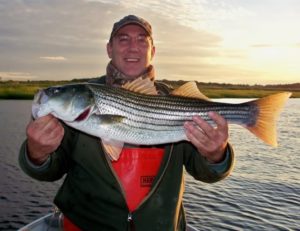
David O’Hearn is not easy to reach. If you want to sit down and talk, you need to catch him at work or during a blizzard. Otherwise, he is out doing something on Great Bay. That something does not include talking on a cell phone. David loves to clam, do a little trapping, harvest oysters, fish for stripers, catch a few smelts, and trap some lobsters. He always did and always will. He is a Bayman.
David grew up on the Squamscott River and still lives near it. The river and the bay attracted him like a magnet. He was enamored with the mysteries of the river and where it went. Great Bay was a whole new universe begging to be explored. He did things in boats as a youth that would appall any parent if they found out. Older, experienced baymen schooled him in fishing, shellfishing, and lobstering. He is married to the Bay, and has never contemplated divorce.
So what’s changed over the decades? In the early 1970s, the exposed mudflats along the Squamscott would stink from pollution that probably came from the already defunct textile mills in Exeter. The smell now is what you would expect. Wildlife along the river is much more prolific.
Water temperature and unusually large rain events, affecting salinity, really alter conditions in the Bay. “I did not catch even one lobster for an entire month after the Mother’s Day flood in 2006,” David says. “Nor did I trap any in Great Bay proper during the prolonged heat waves of the last two summers.” David sees green crabs when the water is warm, red crabs when the temperature is lower, and now even blue crabs at the mouth of the Bellamy. The invasive green crabs have been around for quite a while, but the blue crabs are new and may be a response to warming waters. “The striper fishing has been up and down and there used to be a lot more, and bigger, fish,” says David. He seldom sees any filter feeding pogies (menhaden) anymore.
Tides and rain affect water clarity. More sediment is in suspension. The extent of eelgrass has diminished. The last couple of years, David has seen a very significant increase in algae blooms and nuisance seaweeds. Pulling his lobster buoys becomes a real chore because the rope is fouled by a mass of plant growth like never before. “I am forced to pull a knife to cut the growth from the line while trying to operate my boat at the same time,” he says.
Though David is prone to voting “no” on most bond issues in Exeter, he is supporting the one this March to approve funds that will allow the town to move ahead with their new sewage treatment plant. “That new plant will reduce nitrogen that is currently wreaking havoc with Great Bay,” he says. David also supports the removal of the Great Dam in Exeter in order to maximize fish passage.
There is no question that David loves Great Bay. My sense is that he will pass on to others what he has learned from those who came before. David, and folks like him, is one reason that Great Bay needs and deserves whatever work is necessary to protect and improve it. Learn more about David and his love of Great Bay.
Ray Konisky
Ray Konisky of The Nature Conservancy (TNC) knows oysters. And Great Bay appreciates it. Since 2009, Ray, along with Ray Grizzle of the UNH Jackson Estuarine Laboratory, has worked to create 13 acres of “spawner sanctuaries,” new reefs with three million oysters, in Great Bay. Ten more acres of new live oyster reef are planned for the next two years.
Why? Oysters are filter feeders. For a variety of reasons, including pollution, overharvesting, and disease, Great Bay lost hundreds of acres of healthy beds starting in the 1990s. Ray and TNC have led this restoration effort, which has the added benefit of removing nitrogen from the estuary. An acre of healthy oysters can remove a half ton of nitrogen every year.
Since 2009, more than 70 families around the bay have raised baby oysters in cages off their docks to seed the new reefs. In 2013 alone, 50 families across eleven Seacoast communities contributed more than 50,000 oysters as part of TNC’s Oyster Conservation Program.
Ray has focused on building oyster restoration into a sustainable program with a diverse funding stream (public and private) and greatly expanded scale of operations. Funding for his project last summer – a combination of oyster and eelgrass restoration in the Piscataqua River – was the direct result of CLF’s advocacy to end illegal stormwater pollution at the Market Street Terminal facility in Portsmouth. When he’s not spending time creating new reefs, Ray is the coordinator of the Partners to Restore New Hampshire’s Estuaries.


